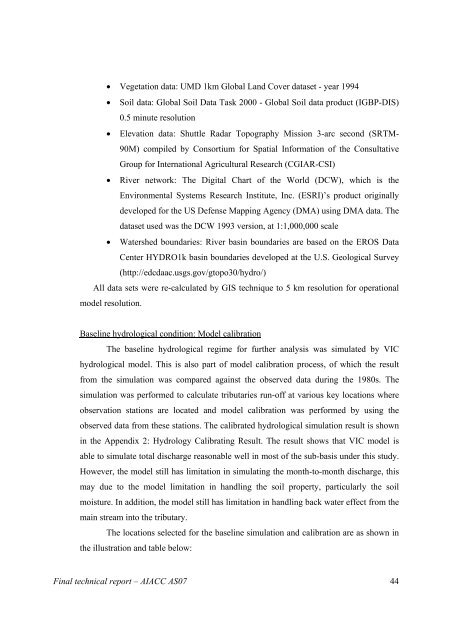Final Technical Report - weADAPT
Final Technical Report - weADAPT
Final Technical Report - weADAPT
- No tags were found...
Create successful ePaper yourself
Turn your PDF publications into a flip-book with our unique Google optimized e-Paper software.
• Vegetation data: UMD 1km Global Land Cover dataset - year 1994<br />
• Soil data: Global Soil Data Task 2000 - Global Soil data product (IGBP-DIS)<br />
0.5 minute resolution<br />
• Elevation data: Shuttle Radar Topography Mission 3-arc second (SRTM-<br />
90M) compiled by Consortium for Spatial Information of the Consultative<br />
Group for International Agricultural Research (CGIAR-CSI)<br />
• River network: The Digital Chart of the World (DCW), which is the<br />
Environmental Systems Research Institute, Inc. (ESRI)’s product originally<br />
developed for the US Defense Mapping Agency (DMA) using DMA data. The<br />
dataset used was the DCW 1993 version, at 1:1,000,000 scale<br />
• Watershed boundaries: River basin boundaries are based on the EROS Data<br />
Center HYDRO1k basin boundaries developed at the U.S. Geological Survey<br />
(http://edcdaac.usgs.gov/gtopo30/hydro/)<br />
All data sets were re-calculated by GIS technique to 5 km resolution for operational<br />
model resolution.<br />
Baseline hydrological condition: Model calibration<br />
The baseline hydrological regime for further analysis was simulated by VIC<br />
hydrological model. This is also part of model calibration process, of which the result<br />
from the simulation was compared against the observed data during the 1980s. The<br />
simulation was performed to calculate tributaries run-off at various key locations where<br />
observation stations are located and model calibration was performed by using the<br />
observed data from these stations. The calibrated hydrological simulation result is shown<br />
in the Appendix 2: Hydrology Calibrating Result. The result shows that VIC model is<br />
able to simulate total discharge reasonable well in most of the sub-basis under this study.<br />
However, the model still has limitation in simulating the month-to-month discharge, this<br />
may due to the model limitation in handling the soil property, particularly the soil<br />
moisture. In addition, the model still has limitation in handling back water effect from the<br />
main stream into the tributary.<br />
The locations selected for the baseline simulation and calibration are as shown in<br />
the illustration and table below:<br />
<strong>Final</strong> technical report – AIACC AS07 44
















